One thing is sure in all cases - the formation of water/alcohol is lot more frequent when running on E85 than when running on gasoline. The system is based on the vented mechanism for the crankcase and is quite simple in its function. When the top point of the oil-room is connected to the intake manifold with a hose, the engine itself sucks in the most of what the oil will releasing. It started when I mount a filter before the intake manifold tube so that no yellow foam could clog the small hole that produces the air flow. Pretty soon you had to replace the filter as there is plenty of yellow foam in the oil. I decided then to build a larger filter - which I did.
The filter is a bandy ball of solid foam which sits between two split in half pet bottles (the smaller model). The cylinder halves are fixed together with a layer tape and through a hole in my ball go a PVC hose down to the Nivea-jar, all the way from the cylinder head. In addition, sits the old fuel filter in the same place and capture it as successfully pass this filtering system to spite. After a while, gather the pink yellow foam (left over), even in the police filter (a common fuel filter) but it will take considerably longer than it did before. I have now changed from a one-time (police) filter into a knock-down filter. This does not collect any yellow foam. This is why one rarely needs to clean it.
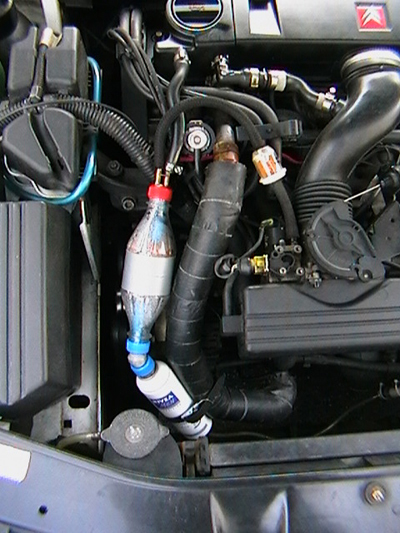
Note that this is a closed system!
Any gaseous substances that can not be condensed goes back and pass again combustion chamber and exhaust systems.
Before the content of the oil space is allowed to go through the filters, it must first go down to a can of thin sheet metal walls that sit near the cooler. The gas that goes into this jar is cooled and the condensate is collected in this jar. This tin can is from a pressurized container contents shaving foam, but with a modified connection. The cap connection is from a large pet bottle and has been glued there with epoxy adhesive.
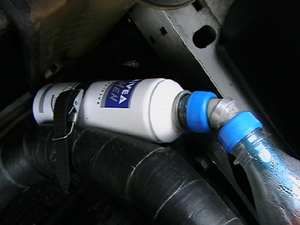
Between the filter unit and the can are a link which is rather simple in their design. Where I have used a VPC tubes that are angled and reinforced with glue - Biltema's Steel Epoxy. VPC (20 mm) is a great fit with the usual pet-stopper. If you make a hole in a pet-stoppers for this type of pipe, it will be a tight connection that seals harder if you pull the cork harder.
The connection between the hoses to the filter unit is a brazed brass story that is fit through the red pet-cap and here I have chosen one bolted joints with silicone sealant.
The result is that there's less or nothing yellow foam in the oil. It is therefore noted that the foam is converted into condensate and the water formed in the engine is only there temporarily and are not allowed with this filter system - to start its journey again.
First I ran the system for quite some time manually, ie I emptied the collection jar with water/alcohol occasionally. But for not so long ago I built a kind of valve that lets water get out in one direction but are barred if the vacuum is brought to work in the opposite direction. Now it's not so easy to form a vacuum because there is always a shipment of gas from the crankcase to the intake manifold. However, is the water in the hose between the collection jar and the valve enough to prevent that air is sucked from outside into the filter system, when the engine is running. This fact questions whether it really needed a valve here, but you could have a small container instead - as a trap for a sink type? Anyway, this thing works as expected even with a valve.
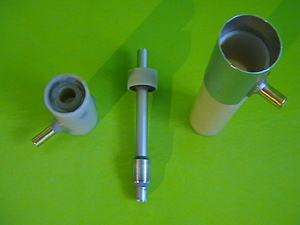
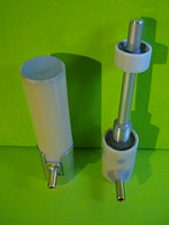
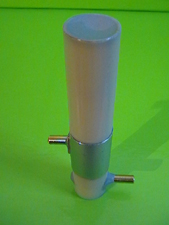
Vacuum valve installed and in use:
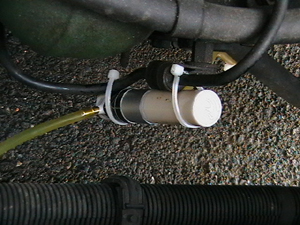
Schematic overview:
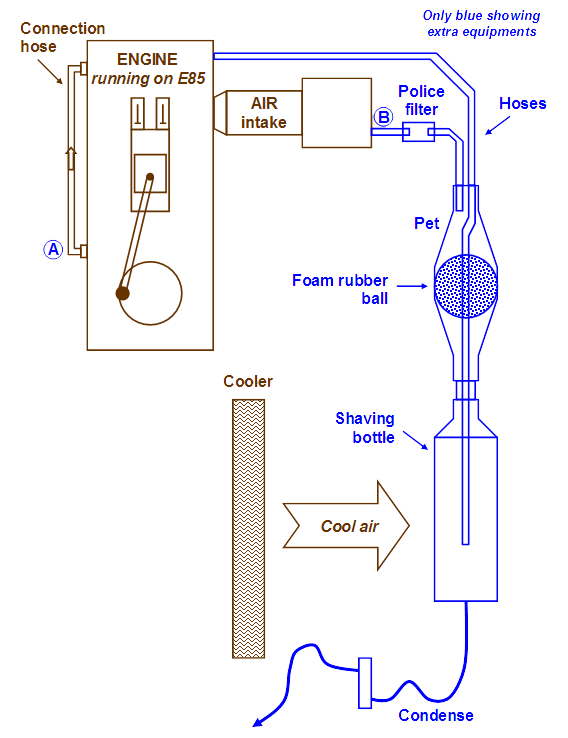
So it is, and maybe it saves an oil change now and then? Therefore will this filter system facilitate the eliminating of the water/ethanol in the oil, and the engine function much better. Thus, one avoid the need to run on gasoline to get the system right again. However, I pick off the whole caboodle before it's time for inspection.
I have failed to examine the condensate and found that it most likely does not consist of anything worse than water. The conductivity is the same as for ordinary tap water and it is transparent and does not smell alcohol, so it can not be ignite by a flame. Furthermore, I did a weigh of the fluid. 100 ml condensate weighed 98 grams. So for example if the rest is ethanol or a mixture of gasoline and ethanol will the condensate consist of 90% water and 10% ethanol.
As a response at the information that this is a case of water, I felt a strong need to further expand this concept, without any further effort...
Is that this water that makes so the oil more quickly becomes second-hand for E85 than for petrol? Because the yellow foam is very real when you choose to run on E85 and when this is water, it is not so difficult to understand the connection. It has been discussed here and there why it is so much water and I can only dare to give my explanation. First, more water is converted from the combustion of ethanol than the combustion of petrol and the second, the temperature sink. This temperature drop can cause the water to linger and that the piston seals will leak through. When the engine has reached operating temperature, the problem should decrease or disappear, but maybe the temperature still is lower in the cylinders, although the engine oil temperature remains unchanged? Since I myself have found this water also collected in the exhaust pipe may the use of E85 lead to puddles of water in the exhaust system catalyst such as depressions and silencers. Moreover, formed more condensate in the Nivea-jar if the outside temperature is low, but it may be due to the cooling of the can is better then.
Shall I dare at this stage expressing me of any conclusions, one can arrive at the following: When the engine temperature is lower for ethanol, decrease also the efficiency. This should be compensated with a longer life and even when given the absence of soot. Since E85 provides significantly less soot, should the engine oil stay fresher than when running on petrol, but the all water in the oil will lead to the contrary - it going to be poor much faster - than for petrol. The conclusion of this is that (by all means) remove the water, as much as it is possible. One can also see it as the crankcase venting under the influence of fuel ethanol is inadequate - because it does not do its job to the extent it should. The water does not want to be transported out of the engine oil but are rather collected in the form of yellow foam.
Another way to streamline the removal of water in the engine oil is to drive the ventilation of the crankcase and the valve body harder. An increased air flow should take with the steam out of the engine faster. In addition, we should also be able to raise the oil temperature for about 5-10 degrees, so that the water becomes more prone to evaporate - but I doubt that a temperature increase of the engine/oil is necessary. I suspect there is quite enough to remove the water with a similar device as mentioned above, because this measure should ensure that the oil can be used for no longer than the equivalent of a gasoline engine. That is to say - extending the range of bytes instead to shorten it, which is the actual case where you do not take any action against the water - against all reason as the manufacturers of the engine oil want to hear. Because the engine oil in ethanol engines not is contaminated by soot.
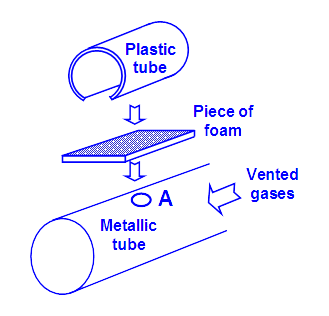
If one wishes to achieve a flow of air going through the crankcase and up to the valve body can you first make an opening at A and then enlarge the opening that is connected to the intake manifold at B (one or a few tenths). The idea is not that it shall lead to a cross draft, but rather make it easier for air to circulate. Opening of A can consist of a hole (about 5 mm). Over the hole is a VPC tube and between this a piece of foam. The tube is held in place by a click and it will be clamped over the lower tube. Such a hole (at A) can also act as a safety valve in the event of a ice plug in the tubing between the crankcase and the valve body. The chilling effect such moves of air through the engine have has to be seen in proportion to all the water that cools the engine.
Now that it's been several years since I took this system in operation so would it be appropriate to put in a report. It was in
2010 that I installed this and now it is 2013-09. Everything is the same except for a few small adjustments. For about three months ago disappeared the foam-jar
because it came loose due to it was filled with water unintentionally. I then switched to a similar cooling-jar (waterproofing spray). The cause of the stopper
will have been dirt in or near the vacuum valve. I did a wash cycle and it seemed to work again. I also tested the valve and realized that I was lucky because
this valve design became very right after the first try - it worked perfectly. About twice in a year, I have had to disassemble the pet-jars, cleaning the foam
and the police filter from white to yellow sludge. The most nourishing information that this report has to offer including probably the yellow goo. It was quite
evident in my engine and it was most likely due to the hole at A. Will such a hole be done, one should be prepared for a lot of formation of yellow goo, because
it is the incoming air that causes it. I recently became aware of it when I plug it, then Admittedly, I read a line about this problem written by a
knowledgeable person. That's what happens if one do not get the hang of all causation that sometimes bewilders our everyday lives ... A warning then for a
hole at A - do not do it! This system will continue in any case to collect the water and the mechanism for emptying works year in and year out. While
cleaning the foam so one can pour detergent into the cooling-jar, so will one prevent formation of dirty clots.
A good question I got was whether the state of piston rings in my car? If piston rings are worn can there be leaks or
so-called ”Blow by” and for that reason; only them (including me) suffer from this foam and water woes. I think it is an essential factor in this context
and not something that should be ignored. In order to be credible shall we not have any skeletons in the closet unplucked. Said and done - a compression gauge
was obtained and this is the result of my car:
As I understand it right, all looks normal and it is not any danger on the roof yet, as we say in Sweden. I also measured on a Hyundai Getz which passed
4000 mil, and the figures were similar but the pressure after the oil-drop, was around 16 bar instead. It was a bigger difference than my car, who moreover is
approaching 20 000 in mileage...
Cylinder 1: |
Cylinder 2: |
Cylinder 3: |
Cylinder 4: |
13,0 bar |
13,0 bar |
12,8 bar |
12,8 bar |
With en teaspoon oil: |
With en teaspoon oil: |
With en teaspoon oil: |
With en teaspoon oil: |
14,5 bar |
13,8 bar |
13,8 bar |
14,5 bar |
Thus, my findings is correct and if you take a look in the ventilation tubes and the like - well, then you may be wondering why this foam must exist?
|
| |
|
| |

